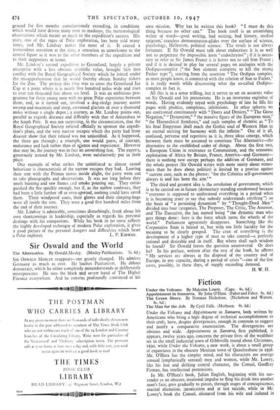Exploration in Greenland
Three Got Through. By Martin Lindsay. (The Falcon Press. 8s. 6d.) IT is always interesting to discover in a book of this sort what in- spired the explorer, not himself a scientist, to set out on such journeys and to endure with patience, often with satisfaction, the rigours of an almost unbearable climate and of a desolate and un- inhabitable landscape. Mr. Lindsay, now a Member of Parliament, is in this, as in other matters, unusually frank. He enlisted, he says, for Adventure. That was all he asked for.
In these days, when the scientific technique of exploration is so highly developed, it is refreshing, though a little surprising, to be told that Polar exploration is not a science but an art and a sport ; an exhilarating and sometimes dangerous sport like steeplechasing or parachuting. If the search for adventure was uppermost in the author's mind when he embarked in the ' Quest ' in 1930 for the icy mountains, the object of the British Arctic Air Route Expedition to Greenland was essentially scientific and utilitarian. The idea of a regular transatlantic air route was scarcely dreamed of seventeen years ago, and a thorough geographical and meteorological survey was necessary to prepare the way for intermediate bases. Here was a pioneering venture of a fascinating kind for the fourteen young explorers engaged in it, and a fuller explanation of the broad problems involved, and of the progress the expedition made in solving them, would have been a welcome diversion from the usual kind of Polar travel-book with its descriptions of camp life and of dog-team driving, interlarded with the not very illuminating reflec- tions of the author on literature and life. All of this Mr. Lindsay provides in plenty, much of it repeated from his previous books, and it tends to become, like the Greenland landscape, a trifle tedious.
The highlight of she first season's work was and will remain Courtauld's solitary vigil on the Ice Cap, where he lay buried under- ground for five months conscientiously recording, in conditions which would have driven many men to madness, the meteorological observations which meant so much to the expedition's success. His story, one of the sagas of Polar exploration, has been told many times, and Mr. Lindsay makes the most of it. It caused a tremendous sensation at the time, a sensation as unwelcome •to the central figure as it was to the other members of the expedition and to their supporters at home.
Mr. Lindsay's second expedition to Greenland, largely a private enterprise with a less obvious scientific value, brought him into conflict with the Royal Geographical Society which he joined under the misapprehension that he would thereby obtain Sunday tickets for the Zoo. The project this time was to cross the Greenland Ice Cap at a point where it is nearly five hundred miles wide and rises to over ten thousand feet above sea level. It was an ambitious pro- gramme for three young men with no great Polar experience between them, and, as it turned out, involved a dog-sledge journey across swamp and mountain and steep, crevassed glaciers of over a thousand miles without a single depot ; a journey, as Mr. Lindsay points out, parallel as regards distance and difficulty with that of Amundsen to the South Pole. It was not surprising, in the circumstances, that the Royal Geographical Society refused officially to sponsor the expedi- tion's plans, and the very narrow escapes' which the party had from disaster show that their refusal was not unjustified. As it happened, the three got through ; a triumph, -one would guess, of courage, endurance and luck rather than of siience and experience. However that may be, the journey was in fact an astonishing feat. The experts, generously treated by Mr. Lindsay, were satisfactorily put in their place.
One example of what strikes the uninitiated as almost casual behaviour is characteristic of the narrow escapes they had. Leaving their tent with the Primus stoves inside alight, the party went out to take photographs and observations. It was not long before they smelt burning and saw flames i.nd smoke pouring out. They extin- guished the fire quickly enough, but if, as the author confesses, they had been a little further off or even upwind, nothing could have saved them. Their windproof coats, their gloves and their sleeping-bags were all inside the tent. They were a good five hundred miles from the end of their journey.
Mr. Lindsay is admirably, sometimes disturbingly, frank about his own shortcomings in leadership, especially as regards his personal dealings with his companions. While his book in no sense reflects the highly developed technique of modern Polar exploration, it gives a good picture of the personal dangers and difficulties which beset



































 Previous page
Previous page